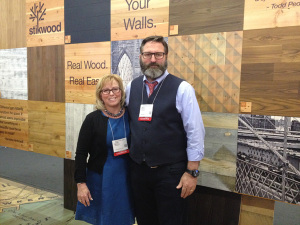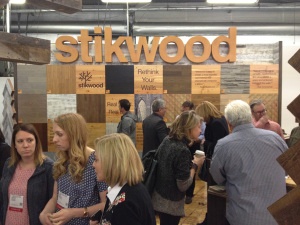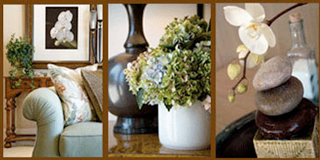Peel & Stick Wood Panels Provide An Instant Reclaimed Look
The showstopper for me at this year’s Architectural Digest Home Design Show in New York was Stikwood, ultrathin wood planks that have an adhesive backing that sticks to just about any surface, creating the look of what would ordinarily be a costly piece of décor.
“I love the smell of wood, the feel of wood. I love everything about wood,” owner and founder Jerry McCall says. “But I’ve always been a bit upset about how wasteful it can be.” The master woodworker came up with a product that would give consumers the look of rustic, reclaimed wall paneling, using as little of the natural resource as possible.

Called Stikwood, his Slicing wood thinly is nothing new, but until recently, nobody in the woodworking world was doing it so efficiently. That’s because if you want to cut a 1/8-inch slab, a 3/16-inch blade is used, which generates more sawdust than useable product. Taking a cue from snowboard manufacturers, McCall sandwiches together layers of wood laminates before cutting the composite into virtually paper-thin slices.
All the wood Stikwood uses is authentic, meaning one plank of reclaimed wood yields one Stikwood plank. However, all the wood underneath the desired top layer is then reused as non-reclaimed-looking panels. McCall explains that not only does Stikwood make much greater use of wood; its lightweight also helps conserve energy in shipping. And once on site, overages, the amount you order over the square footage needed, are fewer than 5%, as opposed to traditional jobs that require about 30% to 40% in excess material.

Stikwood crafts do-it-yourself peel-and-stick wooden wall treatments uses chic materials like reclaimed wine barrel staves, slivered fencing and distressed oak. Stikwood is in distribution by West Elm, a subsidiary of Williams-Sonoma.
As decorative treatments go, Stikwood is moderately priced at about $8 to $12.50 per square foot. But a wall of Stikwood looks like something conceived by an architectural firm and executed by a master carpenter. The product arrives by mail in a neat 5-inch-by-4-foot box, and one pair of hands can install it in a single day without any unique skills beyond the ability to peel backing off of tape strips. Stikwood may be simple, but it’s also substantial: The planking is milled to 1/8 of an inch, and the adhesive is permanent.
“It’s like going to a museum. There’s this history, and aging process that cannot be faked. The effects of time, weather, and wear and tear imparts a type of authenticity that is immediately shown”, says McCall.
“When I see the weathered wood, I think, ‘How many people have touched this? How many who are no longer here, even?’ ” Laura McCall, Jerry’s wife and Stikwood co-founder, says. This poetic aspect of Stikwood means the wine barrel staves carry the rich, warm tones of merlots past, and if you’re lucky, your reclaimed fencing might include a panel where lovers carved their initials years ago.
Stikwood’s mission to use and spread the use of reclaimed wood with 16 finishes and a wide array of design possibilities from traditional to contemporary. Think of you walls as a plank canvas. See more information at StikWood.com.



